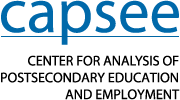By: Judith Scott-Clayton & Basit Zafar | National Bureau of Economic Research | August 2016
In this paper, the authors utilize two complementary quasi-experimental strategies to identify causal effects of the WV PROMISE scholarship, a broad-based state merit aid program, up to 10 years post-college-entry.
By: Susan M. Dynarski, Steven W. Hemelt, & Joshua M. Hyman | National Bureau of Economic Research | October 2013
This paper explores the promises and pitfalls of using National Student Clearinghouse (NSC) data to measure a variety of postsecondary outcomes.
By: Judith Scott-Clayton & Sandy Baum | The Hamilton Project | October 2013
In this discussion paper, the authors propose three major structural reforms to the Pell Grant program.
By: Susan Dynarski & Daniel Kreisman | The Hamilton Project | October 2013
In this discussion paper, the authors propose a better model of student loan repayment.
By: Clive Belfield | Community College Research Center | July 2013
Using data on credit accumulation, award receipt, and earnings, this paper examines whether it is better for students to earn an associate degree before transferring to a four-year college.
By: Susan Dynarski & Judith Scott-Clayton | The Future of Children, 23(1) | Spring 2013
In this article, the authors review what is known, and just as important, what is not known, about how well various student aid programs work.
By: Susan Dynarski, Judith Scott-Clayton, & Mark Wiederspan | National Bureau of Economic Research | January 2013
In this paper, the authors provide a �five-year retrospective of what has changed in the financial aid application process, what has not, and the possibilities for future reform.
Compiled by: Vivian Liu | February 2012
This bibliography is a list of recent studies on the rate of return to college in the United States.
By: Judith Scott-Clayton | National Bureau of Economic Research | January 2012
Recent cohorts of college enrollees are more likely to work, and work substantially more, than those of the past. October CPS data reveal that average labor supply among 18 to 22-year-old full-time undergraduates nearly doubled between 1970 and 2000, rising from 6 hours to 11 hours per week.
By: Thomas Bailey & Clive Belfield | Conference paper | May 2011
This paper reviews and develops the evidence base on occupational higher education in the community college sector.
